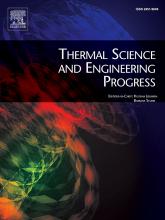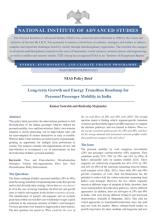Publications

|
M Sai Baba Children's Day https://niascomm.in/2025/11/14/childrens-day/ SciComm@NIAS |

|
Rudrodip Majumdar Sensible heat storage performances of Hytherm 600 oil and energy-harnessing features of glycol-water mixture under simultaneous charging and discharging conditions https://www.sciencedirect.com/science/article/abs/pii/S2451904925011023 Hazarika, R., Majumdar, R., Mahapatra, S., & Saha, S. K. (2025). Sensible heat storage performances of Hytherm 600 oil and energy-harnessing features.... . Thermal Science and Engineering Progress, Vol.68: 104311. A sensible thermal energy storage (TES) system is studied using Hytherm 600 oil as the storage medium and a 30:70 ethylene glycol–water (EG-W) mixture as the discharging fluid, owing to its extended operating temperature range (− 14 ◦C to 105 ◦C) at atmospheric pressure. The EG-W mixture alleviates the working limitations of pure water by lowering the freezing point and elevating the boiling point, making it suitable for solar thermal systems in colder climates and for low-temperature industrial heat recovery without pressurized systems. The analyses establish that higher charging temperatures strongly promote stratification, effectively countering the mixing induced by higher discharge rates. The insights derived from the study establish a crucial foundation for configuring effective TES systems with non-conventional discharging fluids for various low-temperature applications. |

|
Rudrodip Majumdar, Kumar Saurabh Long-term Growth and Energy Transition Roadmap for Personal Passenger Mobility in India http://eprints.nias.res.in/3005/ NIAS Policy Brief (NIAS/NSE/EECP/R/PB/05/2025) |

|
M Sai Baba International Science Centre and Science Museum Day https://niascomm.in/2025/11/10/international-science-centre-and-science-museum-day/ SciComm@NIAS |

|
M Sai Baba World Vegan Month https://niascomm.in/2025/11/06/world-vegan-month/ SciComm@NIAS |

|
V S Ramamurthy Raja Ramanna : A Renaissance Man https://www.worldscientific.com/worldscibooks/10.1142/14346 Srivastava, Dinesh K and V S Ramamurthy (2025). Raja Ramanna A Renaissance Man. World Scientific. |

|
Dinesh Kumar Srivastava Dr Raja Ramanna: A Mentor of Scientists and Nurturer of Scientific Progress of India https://doi.org/10.1142/14346 Srivastava, Dinesh K (2025). Dr Raja Ramanna: A Mentor of Scientists and Nurturer of Scientific Progress of India. In Raja Ramanna A Renaissance Man. World Scientific . |

|
Dinesh Kumar Srivastava co-authored Raja Ramanna : A Renaissance Man https://doi.org/10.1142/14346 Srivastava, Dinesh K and V S Ramamurthy (2025). Raja Ramanna A Renaissance Man. World Scientific. |
